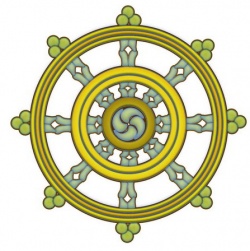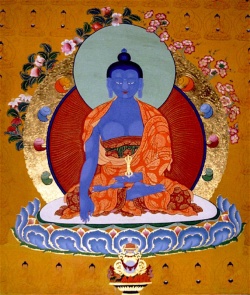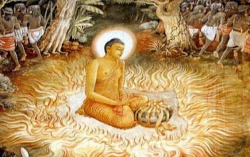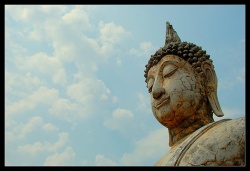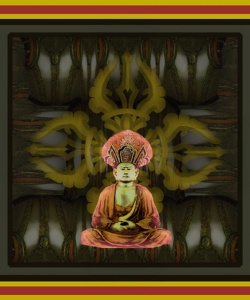Vajrasattva mantra of 100 syllables
This is the text of the 100-syllable mantra of Vajrasattva. You’ll find a link to an audio version of the mantra at the foot of this article. If you want to see the script for this mantra, visit the excellent article at Visible Mantra.
oṃ vajrasattva samayam
anupālaya
vajrasattva tvenopatiṣṭha
dṛḍho me bhava
sutoṣyo me bhava
supoṣyo me bhava
anurakto me bhava
sarva siddhiṃ me prayaccha
sarva karma su ca me
cittaṃ śreyaḥ kuru hūṃ
ha ha ha ha hoḥ
bhagavan sarva tathāgatavajra
mā me muñca
vajrī bhava mahā samaya sattva
aḥ (hūṃ phaṭ)
A symbol of the mind’s inherent purity
Vajrasattva’s name (Tib. dorje sempa) means “diamond being.” He represents the innate purity of the mind.
You can imagine your mind as being like a sky through which clouds pass.
The clouds come and they go, but the sky remains untouched. The sky is inherently blue and clear, and although its blueness and clarity can be obscured it can never be destroyed.
The clouds are like the greed, hatred, and delusion that pollute the mind.
Because of the transient nature of these mental states, they cannot be said to be an inherent part of the mind.
They may obscure the mind’s inherent awareness and compassion, but those qualities are never absent.
The meaning of the mantra
The mantra means:
Oṃ Vajrasattva! Preserve the bond!
As Vajrasattva stand before me.
Be firm for me.
Be greatly pleased for me.
Deeply nourish me.
Love me passionately.
Grant me siddhi in all things,
And in all actions make my mind most excellent. hūṃ!
ha ha ha ha ho!
Blessed One! Vajra of all the Tathāgatas! Do not abandon me.
Be the Vajra-bearer, Being of the Great Bond!
āḥ (hūṃ phaṭ)
Explanation of the mantra
Vessantara, in Meeting the Buddhas, suggests that in the first line (“Oṃ Vajrasattva! Preserve the bond!”) we are acknowledging our alienation from our true nature by calling upon Vajrasattva to preserve the bond, or samaya, whereby we do the Vajrasattva invocation regularly and Vajrasattva for his part responds by bestowing upon us the fruits of the practice. This “bond” represents a mutual commitment on the part of the practitioner and Vajrasattva. In psycho-spiritual terms, if you strive to realize your own innate purity, your innate purity will strive to manifest itself from the depths of the unconscious.
We then (“As Vajrasattva stand before me”) call upon Vajrasattva as a spiritual friend (kalyanamitra), to manifest in our meditation and in our lives.
We entreat Vajrasattva (“Be firm for me”) to be with us constantly. We are endeavoring to constantly come back to recognizing the mind’s true nature.
“Be greatly pleased for me. Deeply nourish me. Love me passionately.” Vajrasattva becomes more like an intimate friend or even a lover, and is no longer just a protector. He’s someone who knows us deeply and cares passionately for us. He is our own deepest nature, so at this stage in the mantra we’re experiencing a reunion with ourselves. In the words of the poet Derek Walcott, “You will love again the stranger who was your self.”
“Grant me siddhi in all things, And in all actions make my mind most excellent.” We now embody the qualities of Vajrasattva himself, and so to some extent we have become him. Siddhi is a Sanskrit word that literally means “perfection,” “accomplishment,” “attainment,” or “success,” and it refers to spiritual power attained through practice.
“Ha ha ha ha ho!” This is the joyful sound of liberation. These five syllables are also said to represent the five Buddha families, which are all emanations of Vajrasattva.
“Blessed One! Vajra of all the Tathāgatas! Do not abandon me.” Having experienced the innate purity of the mind, we aspire always to stay in touch with it. The “Tathāgatas” are the Buddhas, and the “Vajra of all the Tathāgatas” is the innately pure nature of the Awakened mind.
“Be the Vajra-bearer, Being of the Great Bond!” This suggests that we are imploring Vajrasattva to be means for and path to Enlightenment for all beings. He is the vajra-bearer (the representation of Awakening” for all sentient beings.
According to Vessantara, the syllable “hūṃ” is added to the mantra when someone has died, and the syllable “phaṭ” is added in order to subdue demons. Without the hūṃ and the phat the mantra has exatly 100 syllables.
Vajrasattva sits above the Mandala of the Five Buddhas, which includes Akshobya, Ratnasambhava, Amitabha, Amoghasiddhi, and Vairocana. In some traditions he’s regarded as being the ādi-buddha, or the primordial Buddha from whom all other Buddhas emanate. If Vajrasattva is seen as being the mind’s innate purity, then his primordiality and his being the origin of the other Buddhas makes sense — all manifestations of Awakening are nothing more than a revealing of the mind’s innate awareness and compassion.
The most distinctive symbols associated with Vajrasattva are his bell and vajra (or thunderbolt). The bell represents wisdom, and the vajra represents the Bodhisattva’s upaya, or his skill in liberating beings by means of compassion.
Vajrasattva is generally white in color, representing his purity. He is dressed in the Bodhisattva robes of a prince, adorned with jewels, and with long flowing hair. He is eternally young, existing outside of time and space.
Needless to say there are many variants and corruptions of this mantra. The version at the start of this article is a “corrected” version of the mantra that was originally given to Sangharakshita by his teacher, Dudjom Rinpoche. The Sanskrit in that version had become slightly corrupted, and so the original Sanskrit was restored by Sanskrit scholar Sthiramati.
The text of the version chanted by Choden Rinpoche, above, is as follows:
Om vajrasatta samaya
Manupalaya
Vajrasattva denopa titha
Dido me bhava
Suto kayo me bhava
Supo kayo me bhava,
Anurakto me bhava
Sarva siddhi me prayatsa
Sarva karma su tsame
Tsittam shriyam kuru hum
Ha ha ha ha ho
Bhagavan sarva tathagata
Vajra mame muntsa
Vajra bhava
Maha samaya sattva
Ah hum phet
If you compare this with the corrected version above you’ll see that a lot of distortions have crept into the Tibetan version because of the transliteration from Sanskrit, to Tibetan, back to English.
